A compound of development (Dev) and operations (Ops), DevOps is the union of people, process, and technology to continually provide value to customers. It is the combination of cultural philosophies, practices, and tools that increases an organization’s ability to deliver applications and services at high velocity: evolving and improving products at a faster pace than organizations using traditional software development and infrastructure management processes. This speed enables organizations to better serve their customers and compete more effectively in the market.
A DevOps approach is one of many techniques used to execute IT projects that meet business needs. It can coexist with Agile software development; IT service management frameworks, such as ITIL; project management directives, such as Lean and Six Sigma; and other strategies.
“DevOps is not a goal, but a never-ending process of continual improvement.”
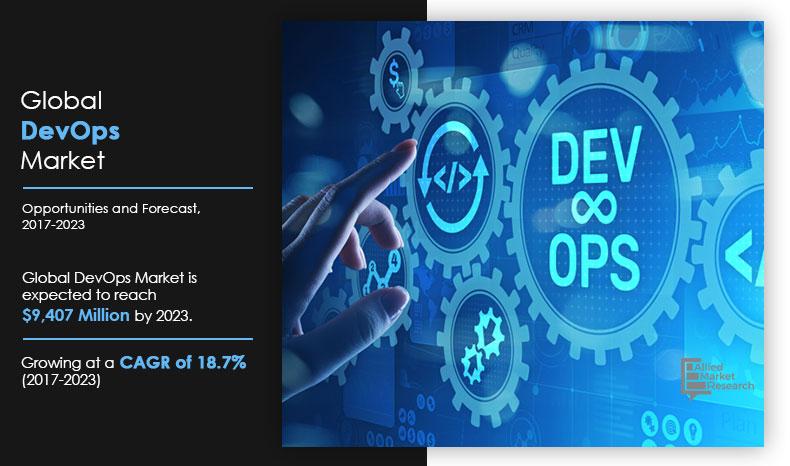
Table of Contents
DevOps Definition
As per Wikipedia : “DevOps is a set of practices that combines software development (Dev) and IT operations (Ops). It aims to shorten the systems development life cycle and provide continuous delivery with high software quality. DevOps is complementary with Agile software development; several DevOps aspects came from Agile methodology.”
AND “a set of practices intended to reduce the time between committing a change to a system and the change being placed into normal production, while ensuring high quality”
As Per Agile Admin : “DevOps is a new term emerging from the collision of two major related trends. The first was also called “agile infrastructure” or “agile operations”; it sprang from applying Agile and Lean approaches to operations work. The second is a much expanded understanding of the value of collaboration between development and operations staff throughout all stages of the development lifecycle when creating and operating a service, and how important operations has become in our increasingly service-oriented world”

Jez Humble says “DevOps is a cross-disciplinary community of practice dedicated to the study of building, evolving and operating rapidly-changing resilient systems at scale.”
Devops means a lot of different things to different people because the discussion around it covers a lot of ground. People talk about it being “developer and operations collaboration,” or it’s “treating your code as infrastructure,” or it’s “using automation,” or “using kanban,” or “a toolchain approach,” or “culture,” or a variety of seemingly loosely related items. The best way to define it in depth is to use a parallel method to the definition of a similarly complex term, agile development.
What is DevOps ?
DevOps is CRISP approach with CALMS as its principles and values
CRISP
C – Collaborative way of working between Dev and Ops (One Team – One Goal)
R – Repeatable process using principles and practices to provide better results to deliver the QUALITY and STABLE product/application
I – Iterative and Incremental approach for continuous improvement
S – Saleable across multiple teams of the product
P – People, Principle, Practices and process oriented disciplinary collaborative approach
CLAMS
C – Culture (promotes collaborative and open culture between Dev and Ops)
A – Automation (automate wherever applicable)
L- Learning (continuous learning & experimentation)
M – Measure (Measure with shared metrics across the Dev and ops for better management)
S – Sharing (Shared delivery process across Dev and Ops to build , deploy, maintain and monitor product with mentality of One Team – One Goal)

After all Devops is collaboration between Dev and Ops using its values, principles, practices and process together to remove the silos and inflexibility and deliver faster and better product to the end user in real sense.
At its essence, itis a culture, a movement, a philosophy. It’s a firm handshake between development and operations that emphasizes a shift in mindset, better collaboration, and tighter integration. It unites agile, git, continuous delivery, automation, and much more, to help development and operations teams be more efficient, innovate faster, and deliver higher value to businesses and customers.
Devops isn’t any single person’s job. It’s everyone’s job.
Which companies are adopting DevOps ?
From early-stage startups to 100-year-old enterprises, DevOps is making significant inroads into IT organizations everywhere. One survey shows that 74% of companies have implemented DevOps in some fashion.
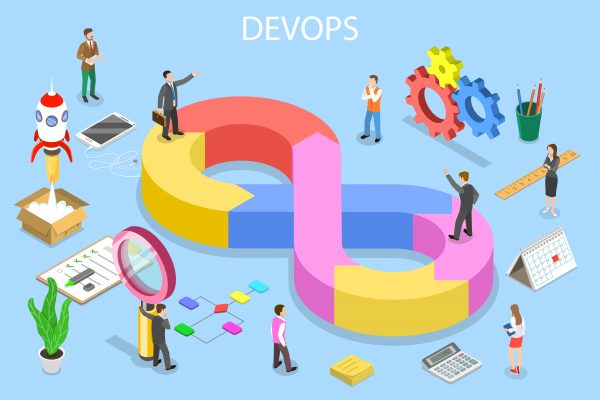
What kinds of companies are embracing DevOps? While web-native “unicorns” like Etsy, Facebook, Amazon, and Netflix are oft-cited examples of DevOps leaders, today every type of business has gotten in this act. Mainstream media company Sony Pictures, financial services behemoth Barclays Bank, and building products manufacturer USG are some of the other DevOps success stories in the news.
Small and medium-sized businesses (SMBs) are also reaping the benefits of DevOps, significantly, there’s plenty of evidence showing that company size by itself is no predictor of its success.
Even government and quasi-government organizations are embracing DevOps.
Flutter – The one thing you definitely should learn in 2021.
DevOps Principles
1. Customer-Centric Action: Dev Ops team must take customer-centric action for that they should constantly invest in products and services.
2. End-To-End Responsibility: The Dev Ops team need to provide performance support until they become end-of-life. This enhances the level of responsibility and the quality of the products engineered.
3. Continuous Improvement: Dev Ops culture focuses on continuous improvement to minimize waste. It continuously speeds up the improvement of product or services offered.
4. Automate everything: Automation is a vital principle of Dev Ops process. This is not only for the software development but also for the entire infrastructure landscape.
5. Work as one team: In the Dev Ops culture role of the designer, developer, and tester are already defined. All they needed to do is work as one team with complete collaboration.
6. Monitor and test everything: It is very important for Dev Ops team to have a robust monitoring and testing procedures.
DevOps Values
The fundamental Dev Ops values are effectively captured in the Agile Manifesto – with perhaps one slight emendation to focus on the overall service or software fully delivered to the customer instead of simply “working software.” Some previous definitions of Dev ops, like Alex Honor’s “People over Process over Tools,” echo basic Agile Manifesto statements and urge dev+ops collaboration.
DevOps Benefits
Speed
Move at high velocity so you can innovate for customers faster, adapt to changing markets better, and grow more efficient at driving business results. The Dev ops model enables your developers and operations teams to achieve these results. For example, microservices and continuous delivery let teams take ownership of services and then release updates to them quicker.
Rapid Delivery
Increase the frequency and pace of releases so you can innovate and improve your product faster. The quicker you can release new features and fix bugs, the faster you can respond to your customers’ needs and build competitive advantage. Continuous integration and continuous delivery are practices that automate the software release process, from build to deploy.
Reliability
Ensure the quality of application updates and infrastructure changes so you can reliably deliver at a more rapid pace while maintaining a positive experience for end users. Use practices like continuous integration and continuous delivery to test that each change is functional and safe. Monitoring and logging practices help you stay informed of performance in real-time.
Scale
Operate and manage your infrastructure and development processes at scale. Automation and consistency help you manage complex or changing systems efficiently and with reduced risk. For example, infrastructure as code helps you manage your development, testing, and production environments in a repeatable and more efficient manner.
Improved Collaboration
Build more effective teams under a Dev ops cultural model, which emphasizes values such as ownership and accountability. Developers and operations teams collaborate closely, share many responsibilities, and combine their workflows. This reduces inefficiencies and saves time (e.g. reduced handover periods between developers and operations, writing code that takes into account the environment in which it is run).
Security
Move quickly while retaining control and preserving compliance. You can adopt a Dev ops model without sacrificing security by using automated compliance policies, fine-grained controls, and configuration management techniques. For example, using infrastructure as code and policy as code, you can define and then track compliance at scale.

DevOps Challenges
- Organizational and IT departmental changes, including new skills and job roles;
- Expensive tools and platforms, including training and support to use them effectively;
- Development and IT tool proliferation;
- Unnecessary, fragile or unsafe automation;
- Scaling Dev ops across multiple projects and teams;
- Riskier deployment due to a fail-fast mentality and job generalization vs. specialization;
- Regulatory compliance, especially when role separation is required; and
- New bottlenecks.
DevOps Metrics
While Dev Ops may seem like a simple integration of two functional roles, measuring the results of a newly established Dev Ops initiative can be challenging. This is why it’s vital to have end-to-end visibility for your applications, infrastructure, reliability, and team health in your Dev ops environment. Sharing key performance metrics with all stakeholders in your digital business lets everyone monitor your Dev ops efforts and prove success at every stage. Leaders benefit from knowing that everyone is aligned and moving forward towards the same goals. And shared insights help teammates collaborate easier and quicker. Know more about the below metrics here.
- Apdex
- Average response time
- CPU percentage usage
- Error rates
- Load average
- Memory percentage usage
- Throughput
- Defect metrics
- Mean time to detection (MTTD)
- Mean time to recovery (MTTR)
- Service-level agreements (SLAs)
- Service-level objectives (SLOs)
- Code commits
- Deployment time and deployment frequency
- Iteration length
- Passed/failed unit tests
- Project lead time
Common Tools used in DevOps Implementation
Teams have many Dev Ops tools to help them facilitate a Dev\ops culture in their organization. Most teams rely on several tools, building custom toolchains that fit their needs for each phase in the application lifecycle. While adopting a specific tool or technology is not the same as adopting Dev Ops, when the Devoos culture is present and the processes are defined, people can implement and streamline Dev Ops practices if they choose the proper tools. Get the tools to put Dev ops into practice:
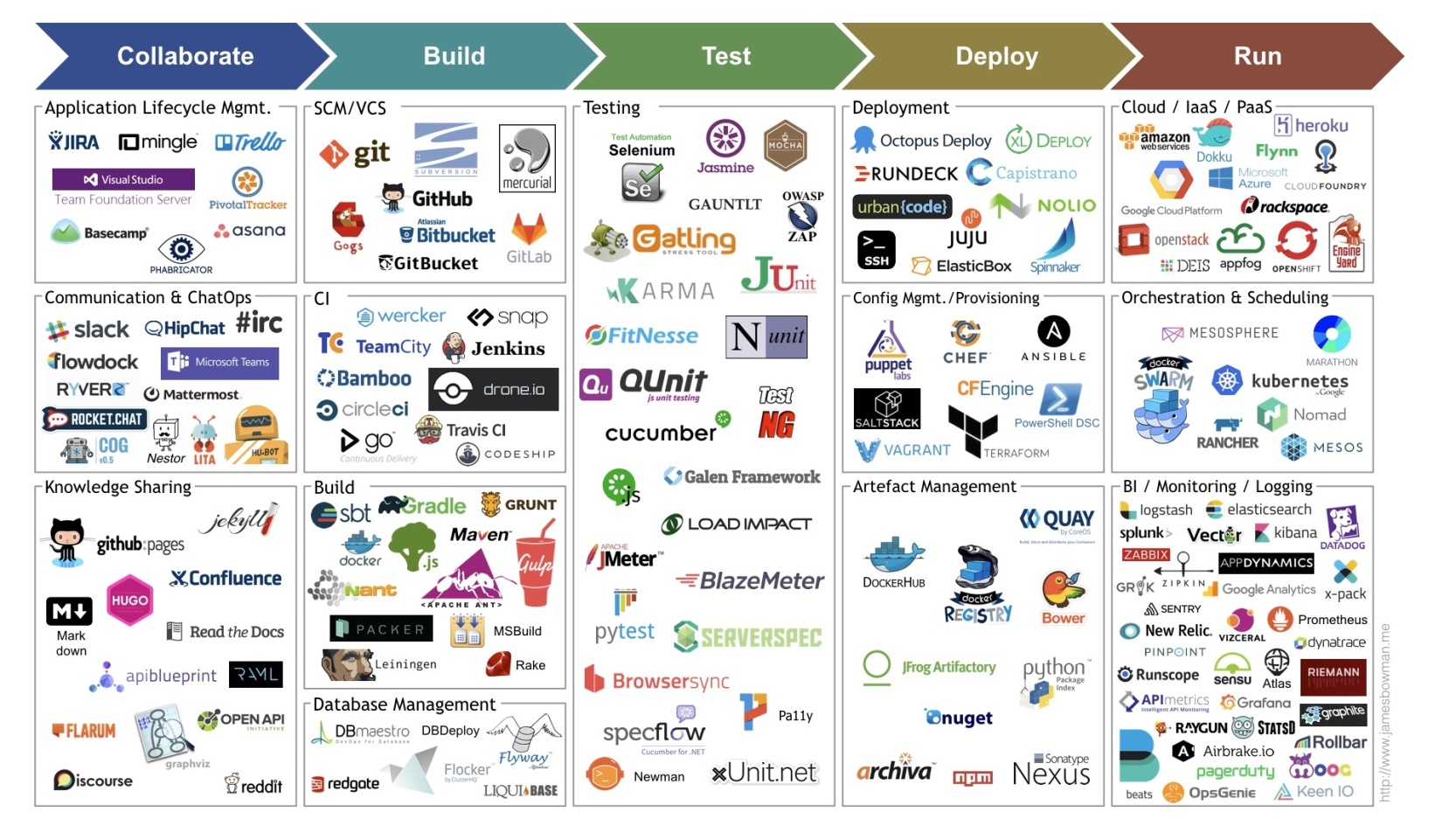
Cloud Computing Platforms
Fundamentally accelerates the access to compute resources to facilitate faster software development and improved application scalability.
- Amazon Web Services
- Pivotal Cloud Foundry
- Google Cloud Platform
- Microsoft Azure
- Rackspace
- OpenStack
Virtualization Platforms
Uses software to abstract hardware and make it possible to run multiple applications at the same for more efficient use of compute resources.
- VMware
- KVM
- Xen
- VirtualBox
- Vagrant
- QEMU
Containerization
Wraps software in a complete filesystem that contains everything it needs to run to enable automated deployments and more reliable software.
- Docker
- rkt
- LXC
Linux OS Installation
Performs unattended operating system installation and configuration.
- Kickstart
- Cobbler
- Fai
Configuration Management and Infrastructure as Code
Allows teams to declare and automate system configuration for better application manageability and IT productivity.
- Puppet
- Chef
- Ansible
- HashiCorp Terraform
- AWS CloudFormation
Test and Build Systems
Facilitates continuous integration and continuous delivery by automating repeatable jobs as part of the software development process.
- Solano Labs
- Jenkins
- Gradle
Application Deployment
Automates the process of making a new version of an application available on one or more web servers.
Capistrano
Monitoring, Alerting, and Trending
Allows digital teams to measure the impact of frequent release cycles across complex, dynamic IT environments.
- New Relic
- PagerDuty
- VictorOps
- Sensu
- xMatters
- Blue Medora
Logging
Provides an intuitive interface for analyzing machine-generated data for easier application-issue detection and resolution.
- PaperTrail
- Logstash
- Loggly
- Logentries
- Splunk
- Sumo Logic
Process Supervisors
Eases the management of operating system services.
- Monit
- runit
- Supervisor
- God
- Blue Pill
- Upstart
- systemd
Security
Helps you keep your applications safe from threats even as you release faster and adopt new technologies.
- Snorby Threat Stack
- Snort
- Veracode
- Sqreen
- Sonatype
- Evident.io
Collaboration and Ticketing
Allows diverse Dev Ops teams to break down organizational silos through better, more transparent communication.
- Slack
- HipChat
- JIRA
- ServiceNow
Orchestration
Software systems that facilitate the automated management, scaling, discovery, and/or deployment of container-based applications or workloads.
- Kubernetes
- Apache Mesos, DC/OS
- HashiCorp Atlas
- Docker Swarm
- AWS Elastic Container Service
CI/CD Pipelines
CI/CD enables Dev Ops teams to frequently validate and deliver applications to the end user through automation during the development lifecycle.
- Jenkins
- GitLab
- CircleCI
Basic Requirements for DevOps Job
Tech background
A DevOps engineer must hold a degree in computer science, engineering, or other related fields. Work experience must be greater than 2 years. This includes work as a developer, system administrator, or one of the members of a Dev Ops-driven team. This is an important requirement along with an understanding of all IT operations.
Automation tool experience.
The knowledge of open source solutions for testing and deployment is a must for a Dev ops engineer. If you use a cloud server, make sure that your candidate has experience with such tools as GitHub, Chef, Puppet, Jenkins, Ansible, Nagios, and Docker. A candidate for this job also must have experience with public clouds such as Amazon AWS, Microsoft Azure, and Google Cloud.
Programming skills.
An engineer not only has to know off-the-shelf tools, but also must have programming experience to cover scripting and coding. Scripting skills usually entail the knowledge of Bash or PowerShell scripts, while coding skills may include Java, C#, C++, Python, PHP, Ruby, etc., or at least some of these languages.
Knowledge of database systems.
At the deployment stage, an engineer works with data processing, which requires experience with both SQL or NoSQL database models.
Communication and interpersonal skills.
Although a good candidate must be well-versed in tech aspects, a Dev ops expert must have strong communication talents. He/she must ensure that a team functions effectively, receives and shares feedback to support continuous delivery. The outcome – a product – depends on his/her ability to effectively communicate with all team members.
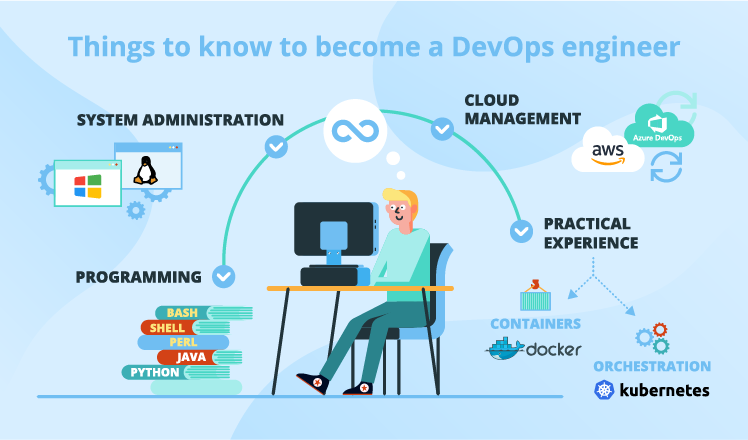
DevOps Engineer Roles
The role of Devops engineer does not fall along one career track. Professionals can enter into the position from a variety of backgrounds. For example, a software developer can gain skills in operations, such as configuration of the hosting infrastructure, to become a Dev ops engineer. Similarly, a systems administrator with coding, scripting and testing knowledge can become a Dev ops engineer.
Many Dev Ops job listings call for container, cloud and CI/CD knowledge, as well as soft skills. A DevOps engineer might also need to change processes and solve organizational problems to achieve business outcomes.
Most entry-level Dev ops jobs require a degree in computer science or a related field that covers coding, QA testing and IT infrastructure components. Higher-level positions may require advanced degrees in systems architecture and software design. People on this career path should also expand their knowledge via Dev ops books, and connect with other members of the community through blogs and conferences.
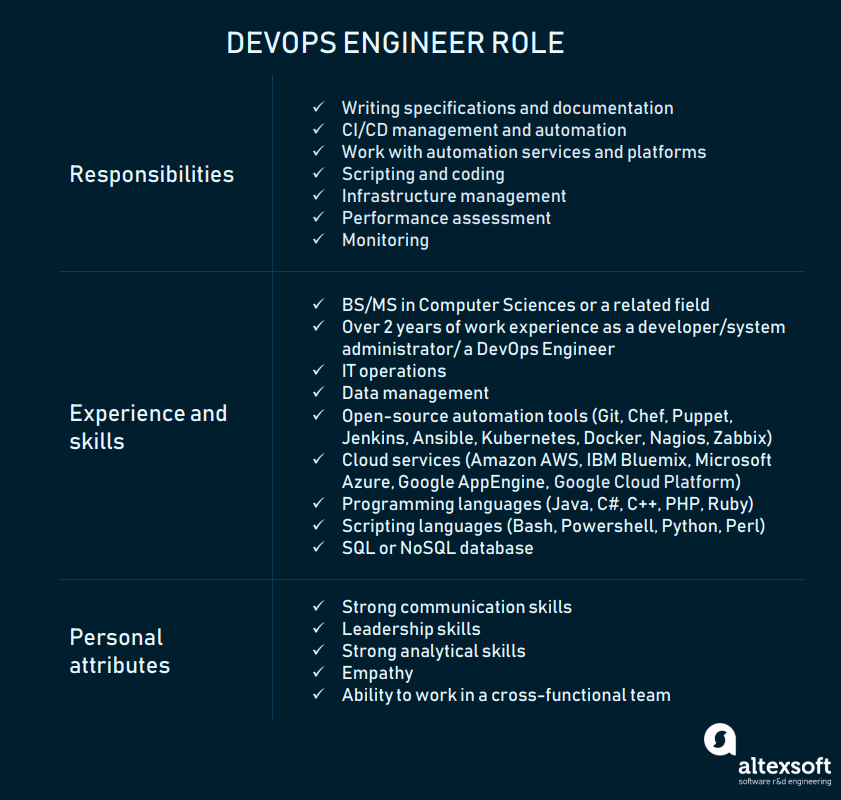
The basic and widely-accepted responsibilities of a Dev Ops engineer are:
- Writing specifications and documentation for the server-side features
- Management of continuous deployment and continuous integration (CI/CD)
- CI/CD script writing
- Performance assessment and monitoring
- Additionally, a Dev Ops engineer can be responsible for IT infrastructure maintenance and management, which comprises hardware, software, network, storages, virtual and remote assets, and control over cloud data storage.
Business Intelligence – Principles, Courses, Study Material and a lot more..
Job Titles similar to DevOps Engineer
- Infrastructure developer
- Site reliability engineer
- Build and release engineer
- Full-stack developer
- Automation specialist
- CI/CD platform engineer
DevOps Engineer Salary
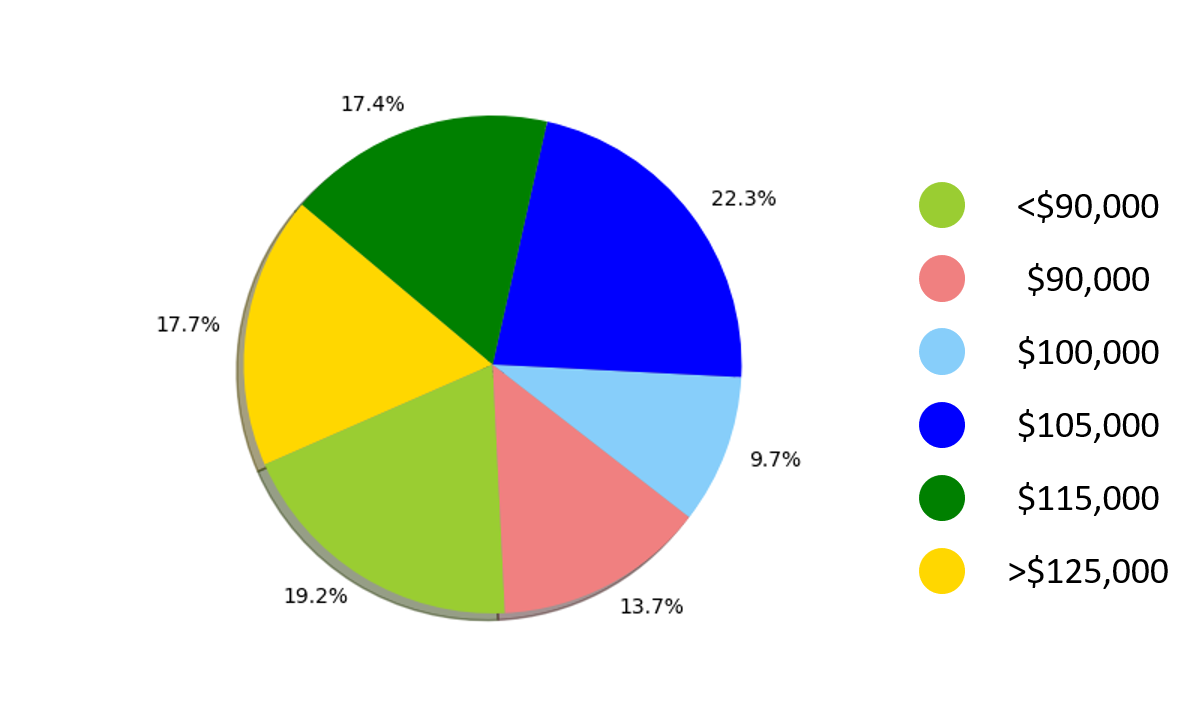
DevOps is one of the most trending IT profession. That is why there is plenty of opportunities out there. As a result, pay scale even for junior level Devops engineer is quite high. Approximate salary of Junior Devops engineer in India is 11, 15,801 per year. The average salary for junior Devops Engineer is $78,696 per year in the United States of America.
According to Indeed and AngelList, 80% of the companies pay more than $90,000 starting salary to a DevOps Engineer. Also, 35% pay at least $115,000, and 17% pay more than $125,000.
DevOps Certfication
DevOps training certification helps anyone who aspires to make a career as a Devops Engineer. Certifications are available from Amazon web services, Red Hat, Microsoft Academy, DevOops Institute.
AWS Certified DevOps Engineer
This DevOps Engineering certificate tests you on how to use the most common Devops patterns to develop, deploy, and maintain applications on AWS. It also evaluates you on the core principles of the Devops methodology.

- Implement and manage continuous delivery systems and methodologies on AWS
- Implement and automate security controls, governance processes, and compliance validation
- Define and deploy monitoring, metrics, and logging systems on AWS
- Implement systems that are highly available, scalable, and self-healing on the AWS platform
- Design, manage, and maintain tools to automate operational processes
This certification has 2 requisites. The certification fee is $300 and duration is 170 minutes.
Red Hat Certification
The new training and certification curriculum is designed to help professionals to demonstrate expertise in technologies closely associated with DevOps such as containers, OpenShift, Ansible, Red Hat Enterprise Linux Atomic Host and Puppet, and includes:
- Developing Containerized Applications course and exam;
- OpenShift Enterprise Administration course and exam;
- Cloud Automation with Ansible course and exam;
- Managing Docker Containers with RHEL Atomic Host course and exam; and
- Configuration Management with Puppet course and exam.
A Red Hat offers different level of certifications for DevOps professionals as follows –
- Red Hat Certificate of Expertise in Platform-as-a-Service
- Red Hat Certificate of Expertise in Containerized Application Development
- Red Hat Certificate of Expertise in Ansible Automation
- Red Hat Certificate of Expertise in Configuration Management
- Red Hat Certificate of Expertise in Container Administration
Devops Institute
The DevOps Institute is the global learning community around emerging DevOps practices. This organization is setting the quality standard for Devops competency-based qualifications. The Devops Institute currently offers three classes and certifications.
The certification course offered by the company are:
- DevOps Foundation
- DevOps Foundation Certified
- Certified Agile Service Manager
- Certified Agile Process Owner
- DevOps Test Engineering
- Continuous Delivery Architecture
- DevOps Leader
- DevSecOps Engineering
DevOps Academy
Official, The Most Popular, And The Most Economical DevOps Certification Programs starting USD 99. Join 1M+ Professionals in DevOps Academy Community. Get info packs, practical tactics, exciting surprises and more, so you can GROW further in your CAREER. By providing outstanding DevOps services relevant to your employers and clients.
Certifications per Technology
- Amazon Web Services certification
- Microsoft Azure certification
- Google Cloud Certifications
- Chef certification
- Ansible Certification
- Saltstack Certification
- Puppet Certification
- Jenkins Certification
- Nginx Certification
- Docker Certification
- Kubernetes Certification
- OpenShift Certification
- Splunk Certification
- AppDynamics Certification
- NewRelic Certification
- Dynatrace Certification
- Elastic Certification
- Pivotal Cloud Foundry Certification
- Atlassian Certification – Jira & Confluence
- Apache Kafka Developer Certification | Confluent
- PagerDuty Course
- signalfx
- HashiCorp – Terraform Certification
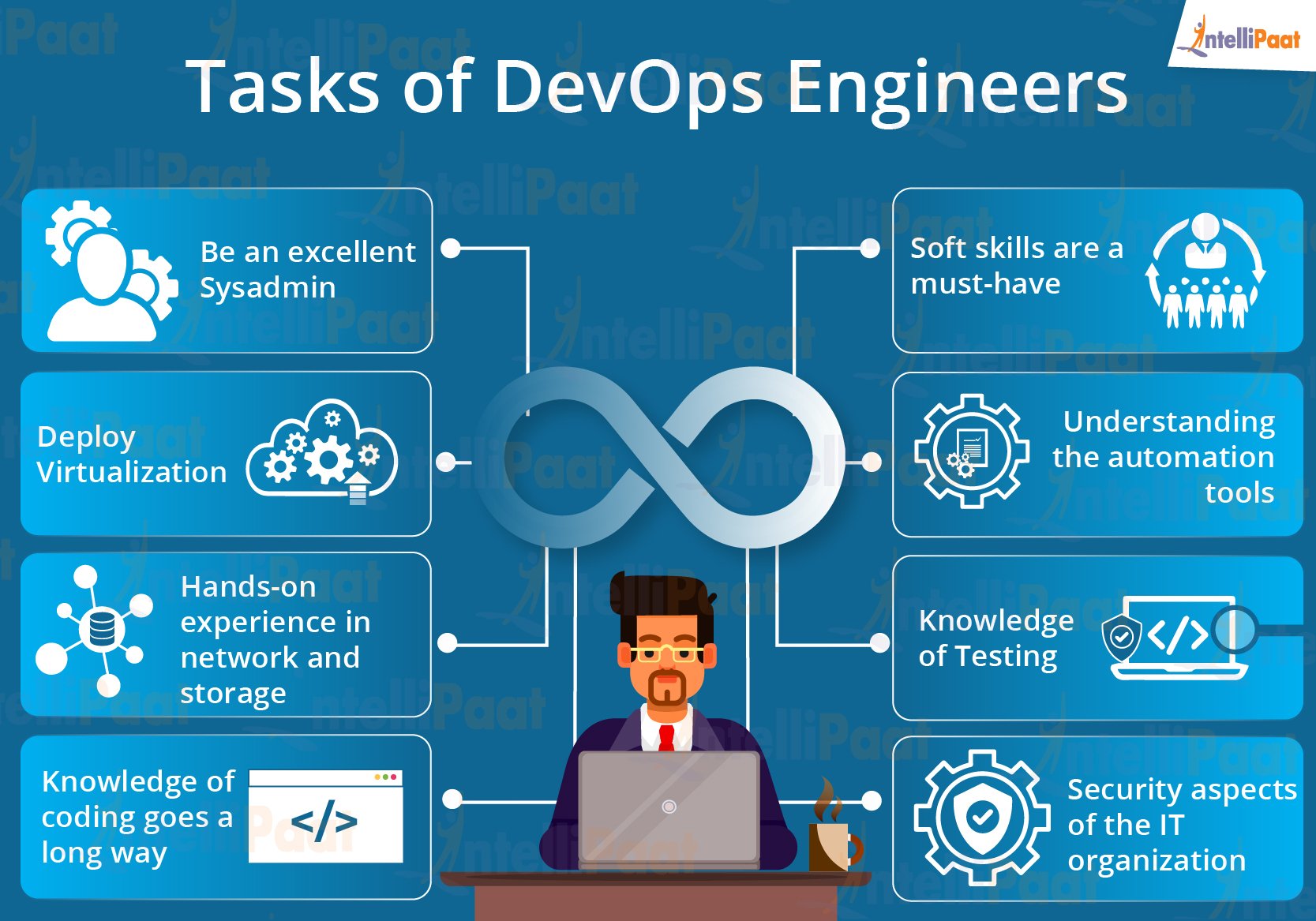
DevOps Courses
Learn DevOps: The Complete Kubernetes Course
- Install and configure Kubernetes (on your laptop/desktop or production grade cluster on AWS)
- Use Docker Client (with kubernetes), kubeadm, kops, or minikube to setup your cluster
- Be able to run stateless and stateful applications on Kubernetes
- Use Healthchecks, Secrets, ConfigMaps, placement strategies using Node/Pod affinity / anti-affinity
- Use StatefulSets to deploy a Cassandra cluster on Kubernetes
- Add users, set quotas/limits, do node maintenance, setup monitoring
- Use Volumes to provide persistence to your containers
- Be able to scale your apps using metrics
- Package applications with Helm and write your own Helm charts for your applications
- Automatically build and deploy your own Helm Charts using Jenkins
- Install and use kubeless to run functions (Serverless) on Kubernetes
- Install and use Istio to deploy a service mesh on Kubernetes
- Continuously Develop using Skaffold
Docker for the Absolute Beginner – Hands On – DevOps
- Beginner level introduction to Docker
- Basic Docker Commands with Hands-On Exercises
- Build Docker images using Dockerfiles with Hands-On Exercises
- Understand what Docker Compose is
- Build Application stack using Docker Compose Files with Hands-On Exercises
- Understand what Docker Swarm is
Learn DevOps: Infrastructure Automation With Terraform
- Understand, use and apply terraform
- Know when to use different features
- Use terraform with AWS
- Use terraform with Packer to create custom images
- Be able to apply DevOps techniques using terraform
DevOps , CI/CD(Continuous Integration/Delivery for Beginners
- Learn the basic concepts of Continuous Integration (CI), Continuous Delivery and Continuous Deployment (CD), and DevOps.
- Understand the pain points in the traditional Software Development Life Cycle which paved the way for CI / CD/ DevOps.
- Learn how business revenue and time-to-market are greatly improved by bringing in CI/CD/Devops.
- Learn how CI / CD / DevOps evolved step by step. This will help build a solid foundation to learn more about the implementation part and the tools involved.
- Learn using illustrations, animations and cartoons. About 90% of the course is illustrated, the remaining 10% consists of crisp bullet point slides.
Azure DevOps Fundamentals for Beginners
- Create an Azure Dev Ops organization
- Align Azure Dev Ops work items using Agile, Scrum, or Basic work processes
- Integrate an Azure Dev Ops code repository with GitHub
- Fork and clone code using multiple tools
- Understand the basic vocabulary of Dev Ops: what it is and why it matters
- CI/CD: Understand how Pipelines facilitate Continuous Implementation and Continuous Deployment
- Commit code changes and track Pull Requests
- Push a code Repo from the command line of an Integrated Development Environment (IDE)
Learn Devops: Continuously Deliver Better Software
- Apply DevOps in your team
- Understand Continuous Delivery
- Automate the Software Development Lifecycle (SDLC)
- Automate the deployment process
- Reduce release time
- Release better software
- Build a highly available and fully scalable application
- Deploy microservices using Docker and Kubernetes
- Automate using Ansible and Chef
DevOps MasterClass : GIT Docker Jenkins Kubernetes Terraform
- An understanding of Dev Ops and the modern DevOps Tools Docker, Kubernetes, Jenkins, Docker Swarm, Kubernetes Helm.
- The ability as Dev Ops Engineer to Automate Code Delivery and Deployment Pipeline Using Jenkins.
- Complete Understanding of Docker Containers & Docker Swarm Orchestration & Kubernetes.
- Learn Building the Apps Dockerize using Docker Containers and Docker File & HELM as DevOps Engineer.
- Be DevOps Master in Kubernetes and Kubernetes Administration from Scratch to Advance Level.
- Kubernetes Development and Complete Deployment on Kubernetes & Docker Containers.
- As CI DevOps Engineer, Jenkins Multiple Integration with Modern Technology Tools like Docker, Code Delivery Pipeline, Git & GitHub .
Master DevOps with Docker, Kubernetes and Azure DevOps
- DevOps with Docker, Kubernetes and Azure DevOps from ZERO, no previous experience required
- 6 Most Popular DevOps Tools – Docker, Kubernetes, Azure Devops, Jenkins, Terraform, and Ansible
- DevOps Building Blocks – Continuous Integration, Continuous Delivery and Infrastructure as Code
- Implement Azure DevOps Pipelines integrating Docker, Kubernetes and Terraform on AWS EKS and Azure AKS
- DevOps with Continuous Integration & Continuous Delivery on Azure DevOps and Jenkins
- Containerization and Container Orchestration for Microservices with Docker and Kubernetes
- DevOps with Docker, Docker Compose and Kubernetes
- Implement Service Discovery, Centralized Configuration and Load Balancing for Docker Microservices deployed in Kubernetes
AWS Certified DevOps Engineer Professional 2020 – Hands On!
- Pass the AWS Certified DevOps Engineer Professional Certification (DOP-C01)
- Create automations between all the various AWS services
- All Hands-On advanced course to provide you the experience needed to pass the exam
- Perform operations that will teach you real-world skills
- Learn DevOps on AWS by doing
- All slides available as a downloadable PDF
DevOps Fundamentals with Azure
- Learn to align resources to maximize the delivery potential
- Manage resources (VMs, networks, disks) on the cloud with Azure
- Understand how containerization technologies work
- Execute tests across your applications with continuous integration
- Use Ansible to manage the configuration of remote servers in order to facilitate the maintenance of a large number of servers
Useful DevOps Resources
- https://devops.com/
- https://en.wikipedia.org/wiki/DevOps
- https://aws.amazon.com/devops/
- https://theagileadmin.com/what-is-devops/
- https://github.com/learn/devops/
DevOps Methods
There are a few common DevOps methods that organizations can use to speed and improve development and product releases. They take the form of software development methodologies and practices. Among the most popular ones are Scrum, Kanban, and Agile:
Scrum.
Scrum defines how members of a team should work together to accelerate development and QA projects. Scrum practices include key workflows and specific terminology (sprints, time boxes, daily scrum [meeting]), and designated roles (Scrum Master, product owner).
Kanban.
Kanban originated from efficiencies gained on the Toyota factory floor. Kanban prescribes that the state of software project work in progress (WIP) be tracked on a Kanban board.
Agile.
Earlier agile software development methods continue to heavily influence DevOps practices and tools. Many DevOps methods, including Scrum and Kanban, incorporate elements of agile programming. Some agile practices are associated with greater responsiveness to changing needs and requirements, documenting requirements as user stories, performing daily standups, and incorporating continuous customer feedback. Agile also prescribes shorter software development lifecycles instead of lengthy, traditional “waterfall” development methods.
DevOps vs Agile
Agile and DevOps serve complementary roles: several standard DevOps practices such as automated build and test, continuous integration, and continuous delivery originated in the Agile world, which dates (informally) to the 1990s, and formally to 2001. Agile can be viewed as addressing communication gaps between customers and developers, while DevOps addresses gaps between developers and IT operations / infrastructure. Also, DevOps has focus on the deployment of developed software, whether it is developed via Agile or other methodologies.
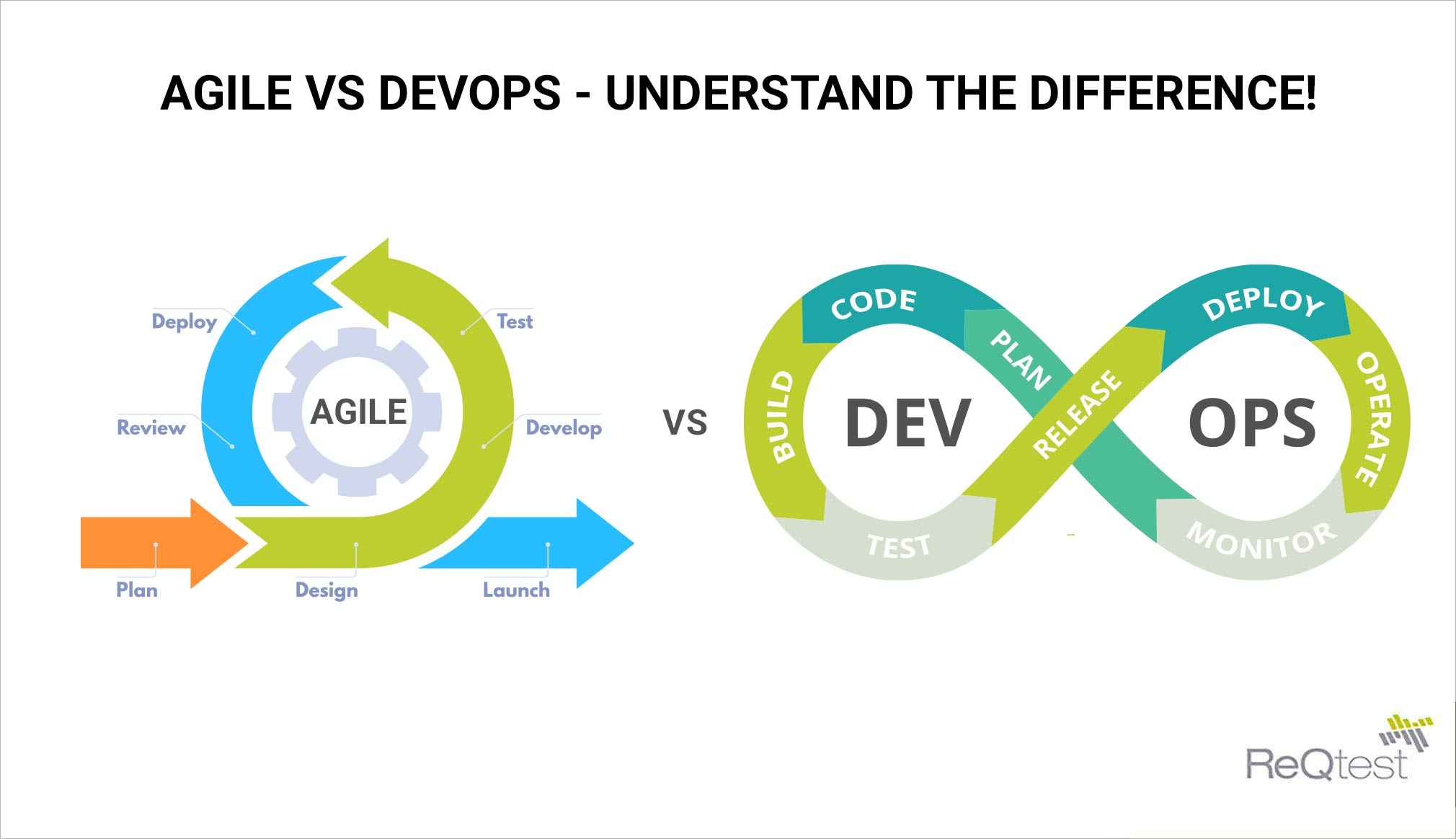
Agile enables developers to deliver their functions every two weeks to respond to changing business needs. DevOps focuses on the operational side of the software development lifecycle, reducing handoffs from developer to operations teams, reducing the time to testing and deploying code, and decreasing errors and downtime of operational systems.
DevOps vs ArchOps
ArchOps presents an extension for DevOps practice, starting from software architecture artifacts, instead of source code, for operation deployment. ArchOps states that architectural models are first-class entities in software development, deployment, and operations.
DevOps vs SysOps
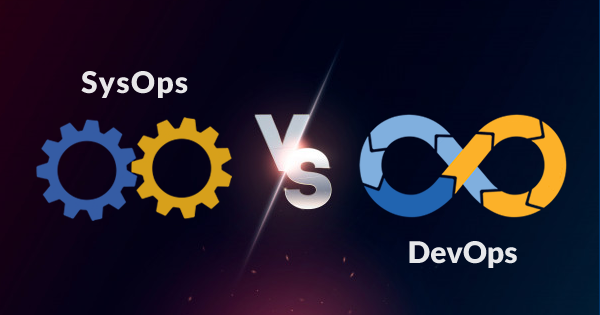
SysOps typically denotes an IT administrator or IT team managing production deployment and support for a large, distributed application, such as a SaaS product. As with DevOps adopters, SysOps teams should be versed in cloud computing and automation, as well as other technologies that enable applications to perform well at a large scale. SysOps teams troubleshoot IT outages and incidents, monitor for performance problems, enforce security rules and optimize operations.
While SysOps professionals are likely to use some development tools and understand development processes, their work is not as enmeshed with development as in a DevOps job. However, SysOps roles can exist within DevOps and SRE organizations.
DevOps vs TestOps
TestOps is to hardware development what DevOps is to software development. The idea is a toolchain that links design and test operations together. In the case of hardware, design means EDA tools and the CAD department, and test means electronic measurement equipment like oscilloscopes and so on.
DevOps vs GitOps
Another variation on DevOps, or a different faction of the same movement, is GitOps. So named because of its focus on the eponymous repository and version control technology, GitOps espouses declarative source control over application and infrastructure code. Everything about the software — from feature requirements to the deployment environment — comes from a single source of truth.
DevOps vs Continuous Delivery
Continuous delivery and DevOps have common goals and are often used in conjunction, but there are subtle differences.
While continuous delivery is focused on automating the processes in software delivery, DevOps also focuses on the organizational change to support great collaboration between the many functions involved.
DevOps and continuous delivery share a common background in agile methods and lean thinking: small and frequent changes with focused value to the end customer. Lean management and continuous delivery are fundamental to delivering value faster, in a sustainable way. Continuous delivery focuses on making sure the software is always in a releasable state throughout its lifecycle. This makes it cheaper and less risky to deliver the software. Improved collaboration and communication both between and within organizational teams can help achieve faster time to market, with reduced risks.
DevOps vs DataOps
The application of continuous delivery and DevOps to data analytics has been termed DataOps. DataOps seeks to integrate data engineering, data integration, data quality, data security, and data privacy with operations. It applies principles from DevOps, Agile Development and the statistical process control, used in lean manufacturing, to improve the cycle time of extracting value from data analytics.
DevOps vs Site-reliability engineering

In 2003, Google developed site reliability engineering (SRE), an approach for releasing new features continuously into large-scale high-availability systems while maintaining high-quality end-user experience. While SRE predates the development of DevOps, they are generally viewed as being related to each other. Site reliability engineering arose concurrently with Agile and DevOps. It is essentially a programming- and automation-focused approach to the software development lifecycle. Problems should be solved in a way that prevents them from occurring again.
While DevOps also can extend to business stakeholders, SRE typically stays within the confines of IT processes.
DevOps vs Systems administration
DevOps is often viewed as an approach to applying systems administration work to cloud technology.
DevOps vs WinOps
WinOps (a portmanteau of “Windows” and “DevOps”) is a term used referring to the cultural movement of DevOps practices for a Microsoft-centric view. It emphasizes the use of the cloud, automation and integrating development and IT operations into one fluid method on the Windows platform. The term ‘WinOps’ was coined at the London DevOps meetup held at Facebook in June 2015. As an amalgamation of Windows and DevOps, it represents the new emphasis on using existing DevOps methodologies in the traditionally less open-source Microsoft space.
DevOps vs DevSecOps
DevSecOps is an augmentation of DevOps to allow for security practices to be integrated into the DevOps approach. The traditional centralized security team model must adopt a federated model allowing each delivery team the ability to factor in the correct security controls into their DevOps practices.
DevOps vs Waterfall
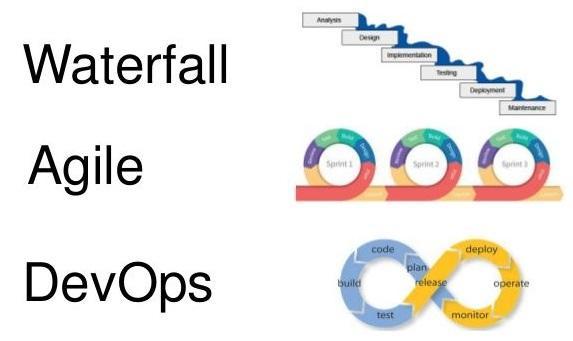
Waterfall development comprises a series of steps and gates in a linear progression to production. Its phases are requirements, analysis, design, coding and implementation, testing, operation and deployment and maintenance. In Waterfall teams, development tests new code in an isolated environment for quality assurance (QA) and — if requirements are met — releases the code to operations for use in production. IT operations deploys multiple releases at once, with extensive controls. Support is operations’ responsibility. Waterfall approaches engender long waits between software releases. Because development and operations teams work separately, developers are not always aware of operational roadblocks that prevent code from working as anticipated.
Know all about Spotfire X – one of the best BI tool in market.
Myths around DevOps
It’s just Devs and Ops
The original agile development guys were mostly thinking about “biz + dev” collaboration, and DevOps is pointing out issues and solutions around “dev + ops” collaboration, but the mature result of all this is “everyone collaborating”. In that sense, DevOps is just a major step for one discipline to join in on the overall culture of agile collaboration that should involve all disciplines in an organization. So whoever is participating in the delivery of the software or service is part of DevOps.
It’s Just A Job Title
Simply taking an existing ops team and calling them “The DevOps Team” doesn’t actually help anything by itself. Nor does changing a job title to “DevOps Engineer.” If you don’t adopt the values and principles above, which require change at an overall system level not simply within a given team, you won’t get all the benefits. DevOps is not a new role or job title. It is a way of working. It is people with both developer and operations skill sets (one, the other, or a mix) working together on product teams to create products.
Its just a Culture
Many people insist that DevOps “is just culture” and you can’t apply the word to a given principle or practice, but I feel like this is overblown and incorrect. Agile has not helped thousands of dev shops because the work on it stopped at “culture,” with admonitions to hug coworkers and the lead practitioners that identified the best practices simply declaring it was all self-evident and refusing to be any more prescriptive.
Its just implementing a set of Tools
DevOps is also not simply implementing a set of tools. A more commonly accepted definition of DevOps is needed is that having various confusing and poorly structured definitions increases the risk that people will pass by the “theory” and implement the processes or tools of DevOps without the principles in mind, which is definitely an antipattern. Automation is just the exercise of power, and unwise automation can do as much damage as wise automation can bring benefit.
Its only meant for Enterprises
Its a myth that DevOps is more appropriate for large enterprise software and is kind of an overkill and too complicated if we only to mid size software like mobile applications. On the contracry, It’s a lot easier to do DevOps in smaller teams (fewer barriers to collaboration). Pretty much any group of techies above about 1 person can suffer from bottlenecks, poor communication, sloppy manual work instead of automation, etc. None of this has anything to do with scale except in that implementation can have special challenges at scale (like Agile).
How to start Learning DevOps ?
It starts with you yourself learning about the values, principles, methods, and practices of DevOps and trying to spread it via whatever channel is most effective – telling fellow techies, getting management buyin, just starting to implement things in a more DevOps way yourself and letting success speak for itself… People will try to tell you how things can rise to success in your org, but that advice is usually more policy and wishful thinking than reality. Observe how other popular things in your organization have arisen and gained currency and try those same channels. And keep learning.
Free Learning Materials on DevOps
Explore what DevOps is (and isn’t) and learn how to get started with Azure DevOps. In this learning path, you will get started on your DevOps journey. You will:

- See how value stream maps can help you evaluate your current processes and technologies
- Sign up for your free Azure DevOps organization
- Learn how to plan and track work items using Azure Boards
- Optimize sprint workloads across multiple Agile teams
Google’s Site Reliability Engineering (SRE) book is free online and required reading for understanding the practices and principles behind keeping the largest websites alive. Note though that some of the advice in the book will be considered controversial at more stodgy traditional organizations that have done operations differently for a long time.
This course is an introductory course to Docker and docker-compose. Also peek into the various parts that web services consist of such as reverse proxies, databases etc. Course material has been done by Jami Kousa with the help of University of Helsinki’s Toska and numerous course attendees. This material is based on gist by Matti Paksula. Course certificate is also available.
Steps to complete this learning path :
- GitHub Actions: Hello World Automation is key for streamlining your work processes, and GitHub Actions are the best way to supercharge your workflow. This quick introduction will teach you how to create a Docker-based action and write a workflow to use the action.
- GitHub Actions: Continuous Integration GitHub Actions makes it easier than ever to incorporate continuous integration (CI) into your repositories. This course will get you from zero-to-CI by setting up two workflow files to automate the way you work.
- GitHub Actions: Publish to GitHub Packages GitHub Actions makes it easier than ever to incorporate continuous delivery (CD) into your repositories. This course will teach you what is needed to test and deliver artifacts that are ready for deployment.
- GitHub Actions: Continuous Delivery with Azure This course is about continuous delivery, or CD, with GitHub Actions and Azure. CD is a crucial part of modern software development, and it can have a monumental impact on development projects.
- GitHub Actions: Continuous Delivery with AWS This course is about continuous delivery, or CD, with GitHub Actions and AWS. CD is a crucial part of modern software development, and it can have a monumental impact on development projects.
- GitHub Actions: Writing JavaScript Actions Over the duration of this course you will learn the skills needed to begin using and customizing GitHub Actions to fit your unique workflow scenarios by creating JavaScript-based actions.
- GitHub Actions: Write Docker container actions This course will teach you the skills needed to begin using and customizing Docker container based actions to fit your unique workflow scenarios by creating Docker-based actions.
- GitHub Actions: Using GitHub Script GitHub Script is a special action that allows using octokit/rest.js directly in a workflow file. Over the duration of this course you will learn the skills needed to begin using the GitHub Script action to interact with your repository which will save you
- Migrating from Azure Pipelines to GitHub Actions : This document from GitHub Help highlights the key differences between the two platforms and explains how to approach a migration to GitHub Actions.
- Migrating from Jenkins to GitHub Actions : This document from GitHub Help highlights the key differences between the two platforms and explains how to approach a migration to GitHub Actions.
- Mirating from CircleCI to GitHub Actions : This document from GitHub Help highlights the key differences between the two platforms and explains how to approach a migration to GitHub Actions.
CL010 : Red Hat OpenStack Technical Overview
A series of on-demand, online videos to help you better understand the basics of cloud computing and Red Hat® OpenStack® Platform.
RH018 : Virtualization and Infrastructure Migration Technical Overview
Discover how to better manage your virtualization assets and move traditional workloads from one virtualization provider to an open virtualization.
RH053 : Red Hat Satellite Technical Overview
Explore the patching, provisioning, and subscription management of your Red Hat infrastructure with an introduction to the core capabilities of Red Hat® Satellite.
RH024 : Red Hat Enterprise Linux Technical Overview
A series of on-demand, online videos that provide a technical introduction to Linux® for IT professionals.
DO007 : Ansible Essentials: Simplicity in Automation Technical Overview
Introduces you to Ansible automation and configuration management, provisioning, deploying, and managing compute infrastructure across cloud, virtual, and physical environments with Ansible.
DO040 :Developing Red Hat Agile Integration Technical Overview
This on-demand video series explains how Red Hat’s comprehensive integration portfolio can help connect data across hybrid infrastructures.
DO080 : Deploying Containerized Applications Technical Overview
Introduces you to Linux containers and container orchestration technology using Docker, Kubernetes, and Red Hat OpenShift Container Platform.
DO092 : Developing Cloud-Native Applications with Microservices Architectures
Learn how to combine different frameworks and tools into a microservices architecture that fits your organizational needs.
Books on DevOps
This handbook by Gene Kim, Patrick Debois, John Willis, John Allspaw, and Jez Humble, came out in late 2016 and is finally a definitive source on DevOps. If you just get one book, get this one. It shows leaders how to replicate incredible outcomes, by showing how to integrate Product Management, Development, QA, IT Operations, and Information Security to elevate your company and win in the marketplace.
The Phoenix Project (A Novel About IT, DevOps, and Helping Your Business Win)
Gene Kim, George Spafford, Kevin Behr – In novel format inspired by the seminal Lean work The Goal, this is a narrative of a DevOps implementation in a troubled software company. In a fast-paced and entertaining style, three luminaries of the DevOps movement deliver a story that anyone who works in IT will recognize. Readers will not only learn how to improve their own IT organizations, they’ll never view IT the same way again.
Lean Software Development: An Agile Toolkit
Mary and Tom Poppendieck – Lean is being increasingly adopted within the DevOps community, but starting from Deming and TPS is somewhat intimidating. This book is the seminal work on Lean in software. In Lean Software Development, Mary and Tom Poppendieck identify seven fundamental “lean” principles, adapt them for the world of software development, and show how they can serve as the foundation for agile development approaches that work. Along the way, they introduce 22 “thinking tools” that can help you customize the right agile practices for any environment.
Your Current role vs DevOps
DevOps has something for everyone in the software chain: developers, operations, and testing. Furthermore, DevOps even touches the business side of the house: managers who monetize the software and executives who worry about the bottom line. Here are some of the benefits cited by each group.
Developers

Automated provisioning is a big win for programmers, because they can stand up a development environment themselves with no paperwork, no lengthy approval cycles, no waiting for IT to provision a server— no lost time. When developers can provision a working environment in minutes, with all the right resources—compute power, storage, network, applications—it changes the way that they work. They can be far more creative and innovative. It’s much easier to try multiple options, run different scenarios, and test their code more thoroughly.
Operations
Early adopters of DevOps methods have found that the increased involvement by developers actually improves system stability. Critically, it turns out that smaller, more frequent releases introduce less variability into the system, lowering the risk of catastrophic failure. Even better, these more limited releases can be made during the day, when everyone is working and available to solve problems, instead of in the middle of the night or on weekends.
Testers
DevOps requires new ways to test software, which challenges test engineers to innovate. With automated provisioning, test engineers can provision a test environment that is virtually identical to the production environment, resulting in more accurate testing and better ability to predict the performance of new releases. As with other groups, test engineer productivity increases thanks to automation and collaboration.
Managers
In a DevOps environment, business stakeholders have greater influence on the development process. Thanks to the collaborative spirit of DevOps, developers actually care about business requirements and foster relationships with product managers. DevOps also gives product managers immediate feedback about the impact of new pricing, features, and product bundles, which allows them to test variations and gauge their effectiveness.
- Faster feedback: The moment a new product or feature gets delivered to customers, product managers start to get real feedback.
- Increased responsiveness: With continuous delivery, DevOps dramatically shortens the time-to-market for new features in response to customer needs.
- Reduced waste and risk: Development resources can fix problems or work on new features without waiting until the next big release.
Executives
What do executives like about DevOps? For one thing, it helps the organization deliver high-quality products and get them to market much faster than competitors relying on traditional methods of software development—actions that impact the bottom line and build brand value.
Another reason is the ability to attract and retain top talent: high-quality developers, system administrators, and test engineers want to work in the most modern, most productive fashion possible. Finally, when developers, operations, and QA work together, top executives rarely get pulled into inter-departmental disputes, leaving them more time to craft the focused business goals that everyone is now pulling together to reach successfully.
DevOps with Python
Python serves as the remedy to any problem in the IT industry. When it comes to DevOps, the main focus or the ultimate goal is to reduce the time taken in the DevOps life cycle to improve efficiency. Python offers a structural solution in terms of automating the tasks in each of the stages in the DevOps life cycle.
The ultimate goal with DevOps is to automate each task in the development life cycle to save time. With python modules and libraries we can do automation using the tools and scripts written in python.
- DevOps uses Python for deployment with modules like fabric, fabtools, cuisine
- In cases of deployment using a platform as a service(Paas), we have a python module called cloudfoundry_client
- The Monitoring stages in the DevOps stages can also be managed by python modules
- Python has modules for almost all databases for database management tasks such as MongoDB, MySQL, PostgreSQL, etc.
- Python has networking,environment-specific and operating system specific modules like OS and subprocess that can handle these details and methods
- We can implement infrastructure-related automation scripts using python that has their SDKs. boto and google-cloud-storage are the SDK modules for AWS and GCP(Google Cloud Platform) respectively
- Python’s OpenStack modules deal with all the operations in the public and private clouds of OpenStack.
- Configuration management tools like Ansible are written in pure python. So in order to add any more custom modules, we write them in python
- Testing frameworks like Selenium can be used for automation testing using python. Even Django can be used to UnitTests using the built-in testing framework.
DevOps with AWS
AWS DevOps is Amazon’s answer to implementing the DevOps philosophy using its cloud platform and dedicated tools and services. In their own words, “AWS provides a set of flexible services designed to enable companies to more rapidly and reliably build and deliver products using AWS and DevOps practices. These services simplify provisioning and managing infrastructure, deploying application code, automating software release processes, and monitoring your application and infrastructure performance.”
AWS DevOps provides application developer teams with the means to efficiently implement continuous integration and continuous delivery (CI/CD). This enables them to securely store and version application source code, while automatically building, testing, and eventually deploying the application to either on-premises environments or to AWS.
AWS DevOps offers a comprehensive selection of tools to build and deploy software in the cloud. Here’s a sample of a few of the more popular tools.

- AWS Cloud Development Kit. This tool is an open-source software development framework that uses familiar programming languages for modeling and provisioning cloud application resources.
- AWS CodeBuild. CodeBuild is an integration service that scales continuously and processes multiple builds. Users can build and test code with continuous scaling.
- AWS CodeDeploy. This tool automates software deployments to several different computer services like Amazon EC2, AWS Fargate, AWS Lambda, or any other on-premises servers you choose.
- AWS CodePipeline. This DevOps tool automates your continuously-delivered code for rapid and accurate updates.
- AWS CodeStar. CodeStar is a particularly useful tool to conduct DevOps on AWS. It provides an intuitive user interface to help users effortlessly develop, build, and deploy applications on AWS. You can set up an entire continuous delivery toolchain in minutes.
- AWS Device Farm. Mobile apps are a big deal today, and this tool helps developers improve the quality of their web and mobile apps by testing them across real mobile devices and desktop browsers hosted in the AWS Cloud. You can even run tests concurrently on different devices and browsers!
DevOps with Docker
Docker tool is basically used to create, deploy, and run the applications by using containers. Through Docker DevOps, developers can pack all parts of an application like libraries and other dependencies easily and ship it out as a single package. Package delivery of the application can keep the developer assured about the timely delivery of the application without being concerned about the type and configuration of the platform.
Docker is a virtual machine, but unlike virtual machines that create a completely separate operating system, Docker allows the applications to use the Linux kernel of the same machine on which it is installed and by taking this benefit, it can make the applications ready to ship to other machines that are running the same Linux OS with somewhat different configurations. In this way, application size is reduced significantly and at the time of shipping, application performance also gets improved.

It is an open-source tool and anyone can use it to meet his or her needs even if they need any additional feature or in case if they need to add a feature that does not exist already in the application. Docker tool was basically designed for both developers and system administrators and this is an important part of DevOps.
Docker has made the code writing capability of the developers quite good and they can just focus on application development rather than being worried about the platform where it will run. They can also start by themselves by using ready to use Docker programs, these programs are basically part of the Docker tool. It minimizes the number of systems that are needed and increases the flexibility of application deployment. As it is a small tool so requires lower overhead and has a small footprint.
Common Questions on DevOps
What Teams contribute to DevOps?
DevOps roles include development, IT, operations, security, and support.
Is DevOps just a Job Title?
DevOps is not limited to a single role. Everyone who takes part in each of the application lifecycle phases must embrace the DevOps culture. However, in some organizations there are a few people or teams whose sole focus is enabling automation, defining practices, and implementing CI/CD pipelines. Sometimes, the official title of these roles is DevOps engineer or DevOps specialist.
Relationship between DevOps and Agile ?
Both DevOps and Agile are modern software development frameworks for producing a product, a launch, or a release. DevOps is a culture, fostering collaboration among all roles involved in the development and maintenance of software. Agile is a development methodology designed to maintain productivity and drive releases with the common reality of changing needs. DevOps and Agile are not mutually exclusive and are often practiced together.
Tools used in DevOps
- Plan. This phase helps define business value and requirements. Jira or Git
- Code. This phase involves software design and the creation of software code. GitHub, GitLab, Bitbucket, or Stash.
- Build. In this phase, you manage software builds and versions, and use automated tools to help compile and package code for future release to production. Docker, Ansible, Puppet, Chef, Gradle, Maven, or JFrog Artifactory.
- Test. This phase involves continuous testing (manual or automated) to ensure optimal code quality. JUnit, Codeception, Selenium, Vagrant, TestNG, or BlazeMeter.
- Deploy. This phase can include tools that help manage, coordinate, schedule, and automate product releases into production. Puppet, Chef, Ansible, Jenkins, Kubernetes, OpenShift, OpenStack, Docker, or Jira.
- Operate. This phase manages software during production. Ansible, Puppet, PowerShell, Chef, Salt, or Otter.
- Monitor. This phase involves identifying and collecting information about issues from a specific software release in production. New Relic, Datadog, Grafana, Wireshark, Splunk, Nagios, or Slack.
Are devops engineers software engineers ?
Yes, the basic requirement of being a DevOps Engineer is a Technical kackground and knowledge of Software Programming, however DevOps is basically integrating business users, developers, test engineers, security engineers, and system administrators into a single workflow, so you can start from any path and become a DevOps Engineer.
Are devops engineers in demand ?
Yes DevOps is currently one of the most sought after job skill along the lines of Data Science.
Are devops engineers developers ?
Devops are a combination of Developers and Operations Engineers, so a basic knowledge of Software Development is a must !
Are devops programmers ?
DevOps has many pillars and programming is one of them. In small companies and Startups, DevOps are also programmers, but in Large Scale Enterprise Companies, Different Devops teams are assigned different roles, programming can be one of them.
Are devops jobs good ?
Yes DevOps are currently one of the highest paid Engineers across the globe, along the lines of Data Scientists.
Can devops engineer work from home ?
Yes, if your role involves mostly programming and development, you can work from home, but for job roles like network, server etc, the employee might have to be present on site.
Can devops work in waterfall?
Waterfall development comprises a series of steps and gates in a linear progression to production. Its phases are requirements, analysis, design, coding and implementation, testing, operation and deployment and maintenance. In Waterfall teams, development tests new code in an isolated environment for quality assurance (QA) and releases the code to operations for use in production.
Can Devops and Agile coexist ?
- DevOps is a practice of bringing development and operations teams together whereas Agile is an iterative approach that focuses on collaboration, customer feedback and small rapid releases.
- DevOps focuses on constant testing and delivery while the Agile process focuses on constant changes.
- DevOps requires relatively a large team while Agile requires a small team.
- DevOps leverages both shifts left and right principles, on the other hand, Agile leverage shift-left principle.
- The target area of Agile is Software development whereas the Target area of DevOps is to give end-to-end business solutions and fast delivery.
- DevOps focuses more on operational and business readiness whereas Agile focuses on functional and non-function readiness.
Can Devops and ITIL coexist ?
Yes, DevOps and ITIL coexist, however, It doesn’t make much sense to try and compare ITIL and DevOps in a vacuum. Instead, compare them based on the problem you’re trying to solve and focus on the tangible benefits you and your team would see from each. ITIL focuses on process, standardization and metrics. DevOps adds in the human element and explores how teams can collaborate to achieve more than their individual efforts alone. Chances are both methodologies will have something to offer and give you at least a starting point on how to improve your operation.
How Devops take advantage of AI ?
A lot of data is generated daily in DevOps. The team is facing issues while accessing that data. Artificial Intelligence helps to compile data from multiple sources and also to organize that data. This data will help in the analysis and give a good picture of trends. Also, AI helps in enhancing process development and testing of development.
Artificial Intelligence helps the DevOps team to focus on tasks that need human intelligence and creativity. Thus reducing errors, increasing speed, and productivity. It helps in managing complex data. Artificial Intelligence enhances automation and accelerates the performance of DevOps. AI enables faster deployment and development life cycle. And in-turn improves customer experience. DevOps allow the team to code, test, release, and monitor software. AI improve all stages by improving automation
How Devops delivery value measured ?
There are different metrics associated to measure effectiveness of DevOps. Please go through in the article above.
Conclusion
A decade into the great DevOps experiment, the data is clear: DevOps is here to stay—and for some very good reasons. Many thought it impossible, but DevOps has succeeded in integrating business users, developers, test engineers, security engineers, and system administrators into a single workflow focused on meeting customer requirements.
There’s no one “right” way to implement DevOps. And like everything else in technology—and anything involving humans—DevOps tooling and practices will change. By standardizing and automating your infrastructure, application delivery, and policies as code, you’ll be ready to adapt quickly—helping your team do their best work faster, while staying competitive.
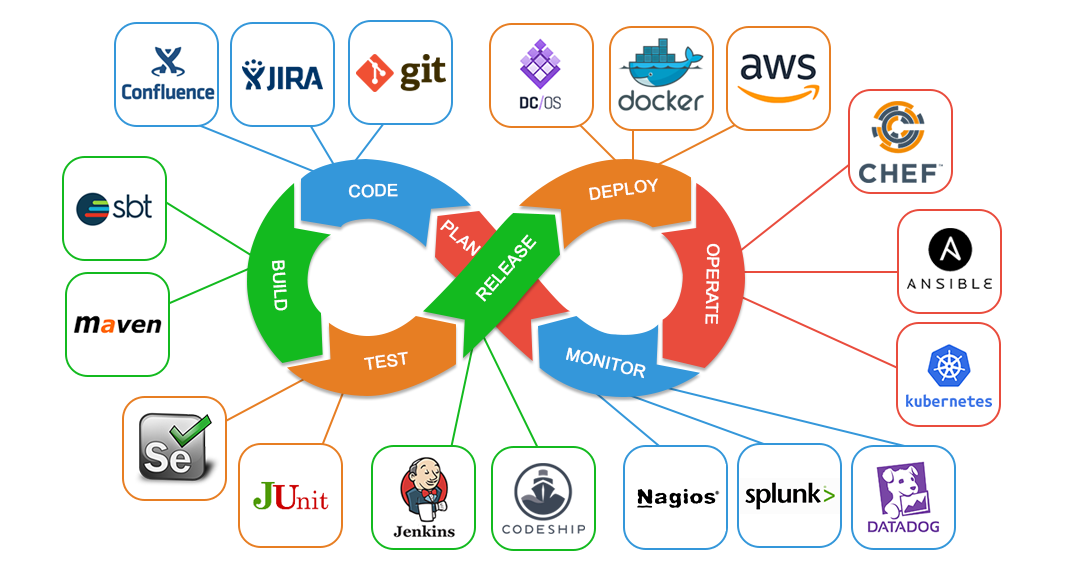



magnificent points altogether, you simply gained a brand new reader. What would you recommend about your post that you made a few days ago? Any positive?
Spot on with this write-up, I actually think this web site needs much more consideration. I抣l in all probability be again to read much more, thanks for that info.